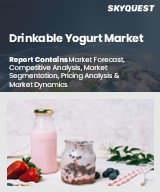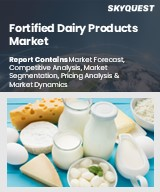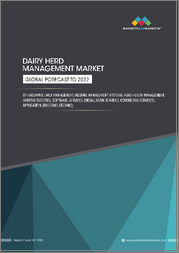
|
시장보고서
상품코드
1661601
인도의 유제품 시장 평가 : 제품 유형별, 최종 이용 산업별, 시장 유형별, 유통 채널별, 영역별, 지역별, 기회, 예측(2018-2032년)India Dairy Market Assessment, By Product Type, By End-User Industry, By Market Type, By Distribution Channel, By Area, By Region, Opportunities, and Forecast, FY2018-FY2032F |
||||||
인도의 유제품 시장은 2024년에는 2,269억 달러로 평가되었습니다. 2032년 말에는 6,328억 달러에 이를 것으로 예측되며, 예측 기간 동안 CAGR은 13.68%를 기록할 것으로 전망됩니다. Z세대나 밀레니얼 세대에 있어서의 식생활 의식이 증가함으로써, 고단백질식이 선호되게 되어, 치즈나 요구르트 등의 유제품의 매출이 증가하는 경향에 있습니다. 또한 택배, 전자상거래, 많은 새로운 시대의 발전이 인도의 유제품 시장의 성장을 크게 뒷받침하고 있습니다.
유제품 시장에는 우유를 비롯하여 버터, 기(맑은 버터), 파닐, 코어, 응유, 탈지 분유 등 많은 부가가치 제품과 아이스크림, 치즈, 요구르트, 유청 등 부가가치가 있는 현대적인 유제품 등 다양한 제품이 있습니다. 지역에 관계없이 우유는 칼슘, 단백질, 인, 비타민과 같은 건강한 영양소를 포함하기 때문에 인도에서는 일상적으로 먹습니다. 8,000만명 이상의 농가들이 우유산업에 직접 지원되어 국민경제의 5%에 기여하고 있습니다.
목차
1) 조사 방법
2) 제품 개요
3) 주요 요약
4) 고객의 음성
소비자 조사는 베이비붐 세대(1946-1964년), X 세대(1965-1976년), Y/밀레니얼 세대(1977-1995년), Z/iGen/센테니얼 세대(1995-2010년)마다 개별적으로 실시합니다.
- a) 포장 제품과 신선한 식품
- b) 브랜드 인지도와 충성도
- c) 브랜드 만족도
- i) 품질
- ii) 수량
- iii) 가격
- iv) 수량과 가격
- v) 포장
- vi) 유통기한
- d) 구매 결정 시 고려되는 요소
- e) 구매 채널
- f) 구매 빈도
5) 인도의 유제품 시장 전망(2018-2032년)
- a) 시장 규모와 예측
- i) 금액별
- ii) 수량별
- b) 시장 점유율과 예측
- i) 제품 유형별
- (1) 액체 우유
- (2) 건조 우유
- (3) 버터기름/인증 버터
- (4) 버터
- (5) 치즈
- (6) 요구르트
- (7) 아이스크림
- (8) 기타
- ii) 최종 용도별
- (1) 가정
- (2) 호텔 및 레스토랑·카페
- (3) 사무실
- (4) 교육기관·호스텔
- (5) 기타
- iii) 시장 유형별
- (1) 조직화
- (2) 비조직화
- iv) 유통 채널별
- (1) 전자상거래
- (2) 슈퍼마켓 및 하이퍼마켓
- (3) 브랜드 스토어(예 : Mother Dairy Outlets 등)
- (4)편의점·백화점
- (5) 기타
- v) 지역별
- (1) 농촌
- (2) 도시
- vi) 지역별
- (1) 북부
- (2) 동부
- (3) 서부 및 중부
- (4) 남부
- vii) 기업별 시장 점유율(%, 2024년)
- i) 제품 유형별
6) 시장 매핑(2023년)
- i) 제품 유형
- ii) 최종 이용 산업별
- iii) 시장 유형별
- iv) 유통 채널별
- v) 영역별
- vi) 지역별
7) 수요 촉진요인
- a) 기술
- b) 축산
- c) 낙농업
- d) 헬스케어
8) 수급 분석(국가 수준)
9) 수출입 분석(국가 수준)
10) 시장 역학(국가 수준)
- a) SWOT 분석
- i) 주요 성장 촉진요인
- ii) 과제
- iii) 성장/이노베이션 기회
- iv) 의심스러운 위협(매크로 및 마이크로)
- b) 가격 분석
- c) 사례 연구(유제품 시장의 주요 기업이 채택한 모범 사례)
11) 시장 동향과 발전
- a) 뉴에이지 스타트업
- b) 포장의 혁신
- c) 유제품 부문의 민영화
- d) 유기농 제품 수요
12) 인도 정부가 수요 증진을 위해 시작한 프로그램
13) 규제 정책과 법적 틀
14) 경쟁 구도
- a) 시장 리더의 경쟁 매트릭스
- b) 시장 리더 시장 수익 분석(%, 2024년)
- c) 신흥 기업와 대체 기업
- d) 합병 및 인수/합작사업(해당하는 경우)
15) 경쟁 전망
- a) 구자라트 협동 우유 판매 연맹
- i) 기업 정보
- ii) 주요 관리직
- iii) 제품 및 서비스
- iv) 재무상황(보고대로)
- v) 주요 시장에 대한 주력과 지리적 존재
- vi) 최근 동향
- b) Tamil Nadu Cooperative Milk Producers Federation Limited(Aavin)
- c) Odisha State Cooperative Milk Producers Federation(OMFED)
- d) West Assam Milk Producers 'Co-operative Union Ltd.(Purabi)
- e) Punjab State Cooperative Milk Producers' Federation Limited(MILKFED/Verka)
- f) Bihar State Milk Co-operative Federation Ltd(Sudha)
- g) Jammu & Kashmir Milk Producer's Co-operative Limited(Snow Cap)
- h) Kwality Ltd.
- i) Heritage Foods Limited
- j) Hatsun Agro Product Ltd
- k) Akshayakalpa Farms and Foods Pvt. Ltd
- l) Parag Milk Foods and Pride of Cows
- m) Mak Biotek(iOrganic)
- n) Nestle India Ltd.
- o) Country Delight Ltd.
위에 언급된 회사는 시장 점유율에 따른 순위를 보유하지 않으며 조사 작업 중 이용 가능한 정보에 따라 변경될 수 있습니다.
16) 전략적 제안
17)기업 소개와 면책사항
KTH 25.03.17India Dairy Market was valued at USD 226.9 billion in FY2024 and is anticipated to reach to USD 632.8 billion by the year end FY2032 growing at a CAGR of 13.68% during the forecast period FY2025-FY2032. The rise in diet consciousness among generation Z and millennials, has led to an increased preference of high-protein diets that tends to boost sales of dairy products such as cheese and yogurt. Also, the trend of door-step deliveries, e-commerce, and many new-age advancements have propelled the much-anticipated growth of the dairy market in India.
The dairy market has a varied range of products such as milk and many value-added products like butter, ghee (clarified butter), paneer, khoa, curd, and skim milk powder and modern dairy products with additional value, such as ice cream, cheese, yoghurt, and whey. Regardless of region, milk consumption is a routine part of the diet in India because of its healthy nutrient contents like calcium, proteins, phosphorus, and vitamins. More than 80 million farmers are directly supported by the industry and contributes 5% to the national economy.
Technological Transformation
The Indian dairy business has seen considerable growth in the last few years owing to the new-age technology-driven solutions. Such solutions are helping in transformation of dairy market with the introduction of health tracking devices for cattle, robotic milking machine, e-commerce marketplaces and Biotechnology. Among this, biotechnology is the young and growing technology of all.
Consumers are highly becoming health-conscious and informed about the process involved in preparation of what they consume. Product traceability is another way that helps consumer know about the process pf collection, packaging, shipped and sorting of the milk or other dairy products that they consume, by using a QR code.
Expansion in Demand for Specialty Dairy Products
The dairy business in India has been exclusively focused on milk from cows and buffaloes and milk-based products for many years. This established tradition has turned over in the last few years by rise in internet usage and increased consumer awareness. Consumers today are extensively moving toward better, healthier options like camel or goat milk. Consumers are becoming more interested in specialty dairy goods like goat milk ghee and flavour-infused camel milk powder.
Government Schemes
For the growth of the milk industry in India, the government has launched several schemes and programmes. Some of them are designed to increase opportunities in India's dairy industry such as NPDD aiming to boost systematic milk production and improve the quality of milk products and milk. The Rastriya Gokul Mission and Dairy Entrepreneurship Development Scheme (DEDS) are few among many other schemes launched by the Indian government.
Additionally, the increasing efforts of various state-run dairy producers to expand their consumer bases through improved distribution networks, economic pricing, and diverse product offerings. These efforts increase accessibility and affordability, in both rural and urban locations, creating consistent demand. By promoting dairy consumption and supporting local farmers, state-run dairies ensure sustainable growth, enhancing the overall industry's economic resilience and encouraging further investment, thus driving the market's expansion.
For instance, in November 2024, the Karnataka Milk Federation (KMF) launched its Nandini brand dairy products in the Delhi-NCR market, aiming to utilize surplus milk production. The launch, attended by Karnataka Chief Minister Siddaramaiah, introduced four milk variants and Nandini curd and buttermilk, priced competitively against rivals like Mother Dairy and Amul. KMF plans to sell 3-4 lakh liters daily in the region, expanding its market presence.
Impact of COVID-19 on India Dairy Market
The dairy business encountered challenges in the early period of the COVID-19 pandemic, painting a changed market outlook in terms of demand and supply. Early on, there was a rapid transition in supply from small-scale dairy farmers to huge co-operatives, which led to this supply demand imbalance. Many producers and cooperatives had to forcibly exit the marketplace due to unavailability or affordability of the facility requirements.
Additionally, Covid-19 has revolutionised the purchasing pattern of the consumers moving more towards online purchases due to enforced policies of lockdown and no-touch point sales. Several dairy players recognise that food safety has fuelled a growing preference among consumers for packaged and branded goods.
Impact of Russia-Ukraine War on India Dairy Market
The dairy market in India witnessed a diverse impact of the prolonged war between Russia and Ukraine directly impacting the shipments of raw materials to manufacture the animal feed, as a result Indian suppliers surging the costs of the final goods sold leading to a change in the dairy market landscape.
Key Player Landscape and Outlook
Dairy market in India is more regional rather than being a national one with a highly fragmented supply. The market is characterised by the presence of a few significant small- to medium-sized local firms in addition to the major players. Key players in the India Dairy Market are listed as under.
Table of Contents
1) Research Methodology
2) Product Overview
3) Executive Summary
4) Voice of Customer
Consumer Survey would be done separately for Baby Boomers: 1946 - 1964. Gen X: 1965 - 1976. Gen Y / Millennials: 1977 - 1995. Gen Z / iGen / Centennials 1995 - 2010
- a) Packaged Products vs Fresh Products
- b) Brand Awareness and Loyalty
- c) Brand Satisfaction
- i) Quality
- ii) Quantity
- iii) Price
- iv) Quantity wrt Price
- v) Packaging
- vi) Shelf Life
- d) Factors Considered in Purchase Decision
- e) Channel of Purchase
- f) Frequency of Purchase
5) India Dairy Market Outlook, FY2018-FY2032F
- a) Market Size & Forecast
- i) By Value
- ii) By Volume
- b) Market Share & Forecast
- i) By Product Type
- (1) Liquid Milk
- (2) Dry Milk
- (3) Ghee/Clarified Butter
- (4) Butter
- (5) Cheese
- (6) Yogurt
- (7) Ice Cream
- (8) Others
- ii) By End-User
- (1) Households
- (2) Hotels/Restaurants/Cafes
- (3) Offices
- (4) Educational Institutions/Hostels
- (5) Others
- iii) By Market Type
- (1) Organized
- (2) Unorganized
- iv) By Distribution Channel
- (1) E-Commerce
- (2) Supermarkets/Hypermarkets
- (3) Brand Stores (E.g., Mother Dairy Outlets, etc.)
- (4) Convenience/Departmental Stores
- (5) Others
- v) By Area
- (1) Rural
- (2) Urban
- vi) By Region
- (1) North
- (2) East
- (3) West & Central
- (4) South
- vii) By Company Market Share (%), FY2024
- i) By Product Type
6) Market Mapping, FY2023
- i) By Product Type
- ii) By End User Industry
- iii) By Market Type
- iv) By Distribution Channel
- v) By Area
- vi) By Region
7) Driving Factors of Demand
- a) Technology
- b) Livestock
- c) Dairy Farming
- d) Healthcare
8) Supply Demand Analysis (Country Level)
9) Import Export Analysis (Country Level)
10) Market Dynamics (Country Level)
- a) SWOT Analysis
- i) Key Drivers
- ii) Challenges
- iii) Growth/Innovation Opportunities
- iv) Suspected Threats (Macro & Micro)
- b) Price Analysis
- c) Case Studies (Best Practices Adopted by Major Players of Dairy Market)
11) Market Trends & Developments
- a) New Age Startups
- b) Packaging Innovations
- c) Privatisation of Dairy Sector
- d) Demand for Organic Products
12) Programs Launched by Government of India for Demand Enhancement
13) Regulatory Policies & Legal Framework
14) Competitive Landscape
- a) Competition Matrix of Market Leaders
- b) Market Revenue Analysis of Market Leaders (in %, FY2024)
- c) Emerging Players and Substitutes
- d) Mergers & Acquisitions/ Joint Ventures (If applicable)
15) Competitive Outlook
- a) Gujarat Cooperative Milk Marketing Federation
- i) Company Details
- ii) Key Management Personnel
- iii) Products & Services
- iv) Financials (As reported)
- v) Key Market Focus & Geographical Presence
- vi) Recent Developments
- b) Tamil Nadu Cooperative Milk Producers Federation Limited (Aavin)
- c) Odisha State Cooperative Milk Producers Federation (OMFED)
- d) West Assam Milk Producers' Co-operative Union Ltd. (Purabi)
- e) Punjab State Cooperative Milk Producers' Federation Limited (MILKFED/Verka)
- f) Bihar State Milk Co-operative Federation Ltd (Sudha)
- g) Jammu & Kashmir Milk Producer's Co-operative Limited (Snow Cap)
- h) Kwality Ltd.
- i) Heritage Foods Limited
- j) Hatsun Agro Product Ltd
- k) Akshayakalpa Farms and Foods Pvt. Ltd
- l) Parag Milk Foods and Pride of Cows
- m) Mak Biotek (iOrganic)
- n) Nestle India Ltd.
- o) Country Delight Ltd.



















